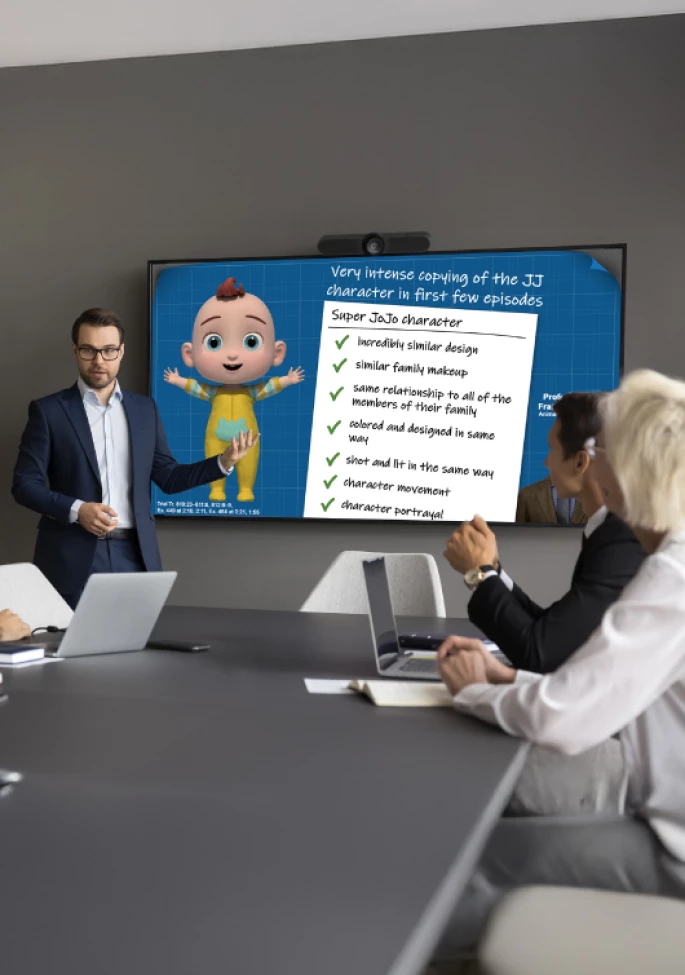The Components of a Good Company
Consultants often emphasize the need for a “good company” story to help jurors see the case in a favorable light. But what exactly does such a story entail, and why is it so important? The answers can be found in the psychology behind human social perception. Namely, when it comes to judging other people, humans rely on two fundamental dimensions: warmth and competence.1
Someone’s “warmth” relates to their perceived morality, trustworthiness, or friendliness, and we use judgments of others’ warmth to determine whether that person is a potential ally with good intentions or a potential threat with bad intentions. We then use judgments of others’ “competence” to determine the extent to which someone has the capacity to act upon and achieve their goals—be they constructive or harmful.2
Because it is more important to know whether someone is a friend or foe than whether they can achieve their goals, warmth is considered “primary.” As the primary dimension, warmth sets the tone or direction of someone’s impression (“I like them” vs. “I don’t like them”), and competence serves to amplify that tone (“I really like them” vs. “I really don’t like them”).3
These tools are so fundamental to our social-judgment toolbox that people will apply them even to more abstract social entities, like corporations. Unfortunately for corporations, people frequently presume them to lack morality or trustworthiness (i.e., to be low in “warmth”), and to have a high capacity to achieve their immoral goals (i.e., to be high in “competence”).4 Taken together, corporations are stereotyped as having bad intentions and the ability to pursue them. One can imagine why this is a hurdle for corporate litigants needing jurors on their side.
Why You Can’t Rely Only on Jury Selection
Ideally, biases like these would always be eliminated from the venire. But in the real world, traditional procedural safeguards such as voir dire and jury selection are under-equipped to weed out biased preconceptions of corporations, as peremptory challenges are limited, and often only the most obviously biased jurors can be caused out.
A good company story is, therefore, essential to make lemonade with the seated jurors you end up with. Left unabated, lingering negative preconceptions can exert a powerful influence on jurors’ decision-making process and final case judgments.
How Jurors’ Perceptions Inform the Case Story They Hear
It is understood among legal psychology scholars that jurors create stories to make sense of the evidence and arrive at what they believe is the correct verdict. Therefore, the side best able to streamline its case into a compelling, memorable story will have the advantage. In addition to their own experiences, perceptions of the parties’ warmth and competence can be one of the first filters through which jurors assess the evidence and judge what story makes the most sense.
Consider, for example, a defendant accused of putting a defective product on the market that jurors presume or perceive as untrustworthy. Claims that the defendant “puts profits over consumer safety”—as well as evidence suggesting it took shortcuts in product testing—will align with jurors’ negative perceptions and be more readily adopted as a result. That is, jurors’ initial negative evaluation of the defendant’s warmth makes it a light lift to accept the plaintiff’s evidence as true and to embrace the plaintiff’s narrative.
Litigants’ perceived competence adds an interesting twist. Consider a data security company that is suing the manufacturer of data storage devices because the devices were breached and customers’ data was stolen. Our research has shown that jurors will, in fact, take issue with the security company plaintiff for failing to protect its customers’ data; from jurors’ perspective, a data security company ought to be uniquely adept at securing data, regardless of whether the manufacturer’s devices were ultimately to blame for the breach. Jurors expected high competence, and they were let down.
In the above experiment, simply changing the identity of the plaintiff from a data security company to a non-security company significantly increased the odds of a plaintiff verdict—despite the fact that the evidence pattern remained static.
So, while jurors presuming your corporation has high competence might seem like a positive starting point, keep in mind that they can be sensitive to positive-expectation violations, which can weigh heavily on jurors’ liability and causation inferences. Did the defendant’s ineptitude produce the breach of contract? Did the plaintiff fail to take obvious precautions and injure themselves? These are the types of questions jurors will be answering as the case unfolds and they piece together the most compelling version of events.
How Jurors’ Perceptions Inform Their Verdicts and Damage Awards
Perhaps most importantly, jurors’ perceptions of a party’s warmth and competence are directly related to verdicts and damage awards, in that they inform jurors’ appraisals of a company’s motives. A party with high perceived warmth and competence, for instance, will enjoy the benefit of jurors motivated to deliver a successful outcome to that party. Indeed, each combination can have unique effects:
| JURORS' PERCEPTIONS OF PARTY'S WARMTH | JURORS' PERCEPTIONS OF PARTY'S COMPETENCE | COMMON RESULT |
| HIGH | HIGH | Very well-liked Jurors motivated to help this party |
| LOW | LOW | Strongly disliked Jurors motivated to hurt (or, at a minimum, not help) this party |
| HIGH | LOW | Liked, but pitied—seen as well-intentioned but lacking capacity Can be beneficial if party's character was a key point of contention, with less focus on competence Jurors motivated to help this party, but will be sensitive to the party's incompetence contributing to the alleged harm |
| LOW | HIGH | Strongly disliked, sometimes to the extent it is seen as something of a supervillain: Nefarious intentions and the capacity to follow through Jurors motivated to punish this party; if defendant, runs the risk of outsized damage awards |
Factors to Consider in Crafting Your Company Story
Perceptions of warmth and competence are malleable, demanding a strong “good company” story. But corporations must also consider what other factors will impact jurors’ perceptions and how to adjust their company story to account for those factors.
One obvious factor is reputation. A highly visible company will be readily known, and its reputation may be polarizing in the panel. Jurors with a negative perception of that company’s morality or trustworthiness, for example, will not be receptive to a company story that simply states, “We are a good company doing good things for people.”
A similar problem exists if a company tries to oversell just how good it is. Such an attempt is likely to be perceived by jurors as disingenuous—confirming their beliefs that it is not trustworthy—and backfire. Instead, a company story that addresses the concerns of the jury head-on, admitting some flaws while emphasizing that jurors don’t truly know who you are as a company, is likely more palatable and would increase jurors’ willingness to consider your version of events.
Another factor is that jurors’ attitudes do not exist in a vacuum but rather in the context of the case and the parties involved. Jurors’ perceptions of a plaintiff’s warmth and competence will be relative to their perceptions of the defendant’s warmth and competence. Simply put, jurors don’t have to like you absolutely; you just don’t want them to like you significantly less than your adversary.
It is also important to anticipate how your company story might interact with what jurors are going to learn during trial. If your story heightens their perceptions of your company’s competence, you are creating an expectation of competent behaviors. So, if there is compelling evidence to the contrary or a company witness who comes off as anything but competent, you will have contributed to your own fall from grace.
There are a multitude of unique factors to account for in any given case, but the examples listed above should convey the need to craft your story with a conscious effort toward considering how it jives with the circumstances of the case and with jurors’ existing knowledge of your company.
Discovering How Jurors Will Feel About Your Company
It is difficult to know how jurors will perceive your company in terms of warmth and competence absent direct measurements. That is why pre-trial jury research is your best bet to assess these important variables, identify opportunities, and shore up vulnerabilities.
A carefully crafted community attitude survey can elucidate how jurors in the venue perceive your company and the issues underlying your case. A jury research project, such as a focus group or mock trial, can go further—assessing how representative jurors’ perceptions of your company inform their views of the evidence and witnesses, whether your company story is proving effective, and what elements will make it even more persuasive at trial.
Close consideration of your case facts and company reputation is an essential start toward a potent “good company” story, but the only real way to know how jurors feel about you is to ask them.
A version of this article originally appeared in the Spring 2022 edition of USLAW Magazine.
References
1 Fiske, S. T., Cuddy, A. J., & Glick, P. (2007). Universal dimensions of social cognition: Warmth and competence. Trends in Cognitive Sciences, 11, 77–83. doi: 10.1016/j.tics.2006.11.005
2 Fiske, S. T., Cuddy, A. J., Glick, P., & Xu, J. (2002). A model of (often mixed) stereotype content: competence and warmth respectively follow from perceived status and competition. Journal of Personality and Social Psychology, 82(6), 878-902. doi: 10.1037//0022-3514.82.6.878
3 Wojciszke, B., Bazinska, R., and Jaworski, M. (1998). On the dominance of moral categories in impression formation. Personality & Social Psychology Bulletin, 24, 1245–1257.
4 Aaker, J., Vohs, K. D., & Mogilner, C. (2010). Nonprofits are seen as warm and for-profits as competent: Firm stereotypes matter. Journal of Consumer Research, 37, 224–237. doi: 10.1086/651566







